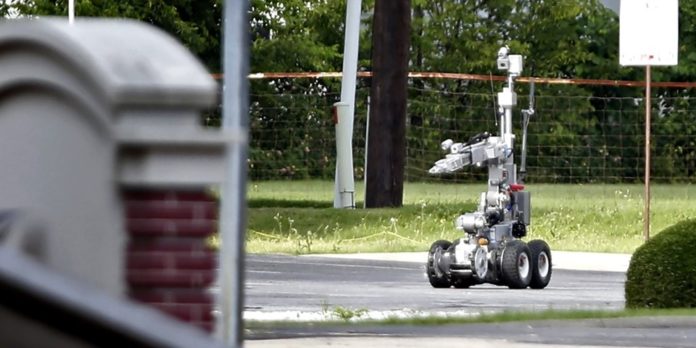
As news emerges that police officers in Dallas, Texas used an armed robot to kill the suspected shooter in Thursday night’s ambush, experts are warning that it represents a sea change in police militarization that only heightens risks to human and constitutional rights.
Dallas Police Chief David Brown said Friday morning during a press conference that police “saw no other option but to use our bomb robot and place a device on its extension for it to detonate” where the suspect had taken refuge in a parking garage as police tried to negotiate with him, adding that he was “deceased as a result of detonating the bomb.”
The suspect, identified as Micah Xavier Johnson, was killed around 2:30am Friday morning after an hours-long standoff with police. The shootings killed five officers and left more than a dozen people injured. Johnson reportedly confirmed that he had acted alone and was not affiliated with any group.
Many noted that this appears to be the first time that domestic police have used a lethal robot to kill a suspect.
According to Marjorie Cohn, Professor Emerita at the Thomas Jefferson School of Law and editor and contributor to Drones and Targeted Killings: Legal, Moral, and Geopolitical Issues, it’s a sign that U.S. law enforcement is continuing to go in “the wrong direction.”
“The fact that the police have a weapon like this, and other weapons like drones and tanks, is an example of the militarization of the police and law enforcement—and goes in the wrong direction,” Cohn told Common Dreams. “We should see the police using humane techniques, interacting on a more humane level with the community, and although certainly the police officers did not deserve to die, this is an indication of something much deeper in the society, and that’s the racism that permeates the police departments across the country. It’s a real tragedy.”
As security expert and University of Pennsylvania professor Matt Blaze noted on Twitter on Friday, numerous safety concerns about the robot’s protocols—for example, how easily it might be hacked—remain unaddressed.
“How was the control link to the Dallas bomb robot secured? Stakes go *way* up when something like this is repurposed as a weapon,” he wrote.
As Popular Science tech editor David Gershgorn also explained:
Repurposing a robot that was created to prevent death by explosion clearly contrasts with the way these machines are normally used. Bomb disposal robots are routinely used to minimize the potential of harm to officers and civilians when disarming or clearing potential explosives from an area. They are often equipped with their own explosive charges and other tools, not to kill, but detonate other potential bombs in the area.
Questions also arose regarding the necessity of the suspect’s killing after he reportedly told police during negotiations that there were “bombs all over” downtown Dallas.
As Cohn noted, officers could have determined where those devices were located, “if in fact there are bombs,” had they left the suspect alive. Moreover, she said, killing him violated his constitutional right to due process.
“Police cannot use deadly force unless there’s an imminent threat of death or great bodily injury to them or other people. If the suspect was holed up in a parking garage and there was nobody in immediate danger from him, the police could have waited him out. They should have arrested him and brought him to trial,” Cohn said. “Due process is not just enshrined in our constitution, it’s also enshrined in the International Covenant on Civil and Political Rights, which the U.S. has ratified, making it part of U.S. law.”
Many noted the connection between potentially the first use of an armed robot in domestic policing and the deployment of such tools in active war zones. Defense technology expert Peter W. Singer wrote on Twitter, “this is 1st use of robot in this way in policing. Marcbot has been ad hoc used this way by troops in Iraq.”
Cohn said, “The same way that the Obama administration uses unmanned drones in other countries to kill people instead of arresting them and bringing them to trial, we see a similar situation here….As the technology develops, we’re going to see the increasing use of military weapons in the hands of the police, which is going to inflame and exacerbate a very volatile situation.”
“We can see that many of the weapons that are being used by the military are in the hands of the police,” she added. “This is a very volatile situation, very dangerous situation, and is only going to make the tensions worse and kill people and violate constitutional rights.”
This article (Police ‘Killer Robot’ Used in Dallas Stirs Human Rights Controversy) by Nadia Prupis originally appeared on CommonDreams.org and is licensed Creative Commons. Image credit: YouTube





Couldn’t a canister of knock out gas have been used instead of a bomb?